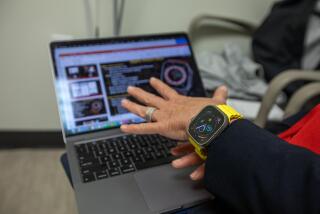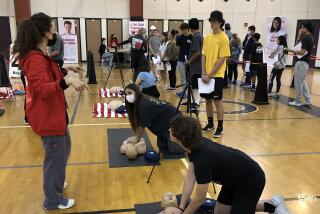Portable Heart Device a Shocking Success
- Share via
Larry Vance and his wife were unloading their tractor-trailer at the new Leesburg, Va., outlet mall when he suddenly slumped over. Rhonda Vance rushed to him, cradled him in her arms and watched helplessly as he turned blue and lost consciousness.
She hollered for someone to call 911. However, even before an ambulance arrived at the scene, Leesburg police officer Steven Pebler showed up.
After a quick check revealed no pulse, Pebler cut open Vance’s shirt and hooked him up to a machine about the size of a “fishing tackle box,” said Rhonda Vance, recalling the Oct. 5 incident.
Pebler called out: “I’m clear. You’re clear. Everybody clear. Shocking now!” With the press of a button, a jolt of electricity ran through the body of the 41-year-old Texan. “I checked for a pulse, and it had returned,” Pebler said.
Portable heart defibrillators are turning up in more and more places these days, and many public health officials say they could save thousands of lives every year.
The machines, portable versions of the devices found in hospital emergency wards but designed to be used by nonmedical personnel, have been on the market since the mid-1980s and are increasingly used on airplanes and in shopping malls, concert halls and office buildings.
About 350,000 people die from out-of-hospital cardiac arrest each year in the United States, and many doctors say they believe that thousands of people could be saved with early use of the machines, which cost about $3,500 and are known as automated external defibrillators, or AEDs.
But concerns remain about protecting those who administer the care from lawsuits if something should go wrong. Some medical professionals also say more research needs to be done on whether it makes sense, both medically and financially, to put the machines in the hands of more nonprofessionals.
“This has been an evolving process all over the country,” said Robert R. Bass, executive director of the Maryland Institute for Emergency Medical Services. “Maybe someday they will be like a fire extinguisher that you buy at Kmart and put on the wall, but we don’t know enough about it yet.”
Sudden cardiac arrest is usually caused by an electrical malfunction of the heart known as ventricular fibrillation, during which the heart quivers and stops pumping blood through the body, causing a person to stop breathing.
The portable defibrillator delivers an electric shock that can restore the heart’s normal beating. Quick treatment is critical because survival rates drop 10% each minute the heart quivers.
Although widespread public access to the portable units remains in the early stage, police officers are considered among the most effective responders outside of rescue crews because they frequently are the first to arrive at emergency scenes and they are used to handling stressful situations.
The portable units give voice commands that walk the responder through the treatment process, analyze the patient’s condition and tell if a shock is needed.
“When you watch ‘ER’ and you see George Clooney doing his thing, it’s the physician watching the heart rate and making the decision,” said Elizabeth Selner, spokeswoman for the Minneapolis-based Survivalink, a manufacturer of the unit. “What we’ve done is put the intelligence in the device.”
Police in Rochester, Minn., have seen a high survival rate since they became the first department in the country to carry the units in 1990. As of last November, 23 of 58 cardiac arrest victims treated by officers survived, said Roger White, a cardiologist at the Mayo Clinic and medical director of the city’s early defibrillation program.
“The police reach a surprising number of patients before an ambulance does,” White said. “They are already out on the streets, and they are mobile.”
More to Read
Sign up for Essential California
The most important California stories and recommendations in your inbox every morning.
You may occasionally receive promotional content from the Los Angeles Times.













